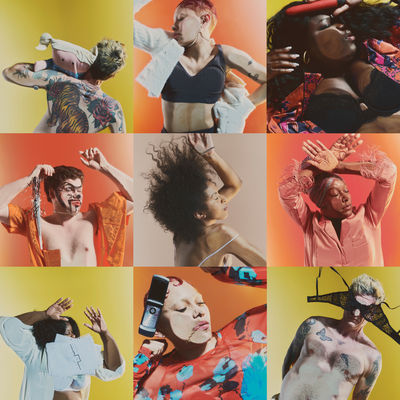05 : 08 : 22 : Weekly Debrief
This week: Minecraft bans NFTs, architecture in the metaverse, Spotify’s latest campaign, a celebration of deep sleep, and Mango’s new teen store design.
1. Minecraft bans NFTs citing inclusivity concerns
US – Massive multiplayer online game Minecraft is banning the sale of NFTs out of concerns that they might foster a culture of ‘have and have-nots’.
One of the most successful games of all time, Minecraft is particularly popular among children, raising questions about whether the promotion of NFTs would be ethical on its platform. The game is in a sandbox format, meaning that players can construct complex worlds and experiences without a predetermined, overarching goal.
While many video game developers have embraced digital collectibles to create new revenue streams, Minecraft says that the adoption of NFTs would go against its values of inclusivity. ‘To ensure that Minecraft players have a safe and inclusive experience, blockchain technologies are not permitted to be integrated inside our Minecraft client and server applications,’ reads a company statement.
By promoting inclusivity and inclusion in virtual spaces, Minecraft is championing the ideas of Affirmative Avatars, empowering player creativity instead of fostering a consumerist culture.
 Six.N.Five for The Row by Everyrealm and Alexander Team, US
Six.N.Five for The Row by Everyrealm and Alexander Team, US
2. Fantasy architecture lays foundations in the metaverse
New York City and Miami – With growing buzz around virtual real estate, The Row is a development of fictional metaverse properties designed by artists, and only accessible to NFT-holding members.
The brainchild of real estate brokerage Alexander Team and launched by metaverse real estate development company Everyrealm, The Row is described as a master-planned real estate development, where design-conscious collectors can purchase virtual residences. It launches with daring digital dwellings designed by six artists, including Six N. Five studio, Misha Kahn and Daniel Arsham.
‘The metaverse has no physics, no weather, and no limitations other than human ingenuity.' says Janine Yorio, CEO of Everyrealm. 'The Row brings together visionary artists best known for their architectural landscapes and collectors seeking a unique, limited edition residence that they can deploy across many different metaverses over time.’
The Row demonstrates how the notion of gated communities that exist IRL will be translated online in the future, allowing the metaverse to carve niches zones for design-conscious or affluent audiences. For more future directions in luxury lifestyles, join us for our Luxury & Hospitality Futures event on 8 September.
3. Spotify’s latest campaign taps visual-first Gen Z
LATAM – Recognising the visually-driven behaviour of Gen Z audiences, the music streaming platform’s latest campaign is putting a spotlight on its young subscribers. The campaign, by Brazilian media agency Soko, uses stop motion, 3D and 2D mediums to create animated films and out-of-home (OOH) adverts.
Aligning with familiar life stages of Gen Z audiences, the work draws on topics such as falling in love or sitting college entrance exams. Soko also chose to work with artists that are currently most popular with Gen Z in Latin America, including Fa & Fon, Fromm, Alexandre Louvenaz and Juan R. Lage. Fabiana Falcao, design and creative leader at Soko, explains the process of selecting artists, saying: ‘We searched from 2D artists to more experimental ones who speak to Gen Z’s maximalism and irony.’
In this way, Spotify tunes into the emotional narratives surrounding music, as well as important scenarios for this cohort. By communicating a strong visual narrative, the platform promotes its audio content in a way that appeals to Gen Viz.
4. CitizenM’s unfiltered campaign celebrates deep sleep
London – To mark the opening of hotels in London and America, CitizenM is transforming the windows of its new properties into a public art exhibition. The hospitality company has tapped photographer Amber Pinkerton to create realistic portraits of guests sleeping that allude to the deep rest each of its hotels promises.
The images, which show guests in various states of undress – some in pyjamas, others dozing off in their clothing while surrounded by mementos from the night before – are purposefully unfiltered. Instead of ‘beauty sleep’, the company is depicting what real relaxation looks like. 'We wanted to show how people actually snooze, to create honest (and therefore more engaging) portraits of sleep – dribble and all,’ says Adam Morton-Delaney, director of KesselsKramer, the agency behind the campaign.
By creating visceral visuals, the company is tapping into the Sensorial Strategies that we explored in Innovation Debrief, where brands translate the sensation of particular feelings through their marketing campaigns.
 Citizens of Sleep campaign by KesselsKramer and photography by Amber Pinkerton for citizenM, UK & US
Citizens of Sleep campaign by KesselsKramer and photography by Amber Pinkerton for citizenM, UK & US
5. Mango’s latest store captures teenage dreams
Spain – In a bid to entice and excite young shoppers, the fashion retailer has unveiled its first Mango Teen store in Barcelona. The result is a highly experiential, escapist store taking inspiration from dreams and surrealism. Ana Hernández, co-founder of Masquespacio, the consultancy behind the project explains: ‘The entrance tunnel makes us go back to that surreal dream we had, taking us to a future in which conventional elements from the past are being considered futuristic for the new generations.’
Throughout the space, various installations invite visitors to let their imagination flow, with objects taking on unexpected functions. A swimming pool, for example, is used as an exhibition element, while a mock hotel reception replaces a traditional cashier desk, and next to it a fake washing machine will help teens recycle their old clothes. Drawing on metaverse worlds, the fitting rooms feature an optical effect that distorts reality – aligning with this generation’s demands for memorable, other-worldly experiences.
Changing consumer needs are driving retailers to rethink bricks-and-mortar stores to be more engaging, sensorial and memorable. Young people especially require this level of interaction and design in physical spaces.
To future-proof your world, visit The Future Laboratory's forecasting platform LS:N Global for daily news, opinions, trends, sector specific insights, and strategic toolkits.
Want to read more?
Become a member today!
Sign up to one of our trends intelligence platform, LS:N Global and get unlimited access to a hive of insights - from microtrends and macro trends to market reports, daily news, research across eight industry sectors and much more.
Discover our memberships
Already a member? Click here to login
